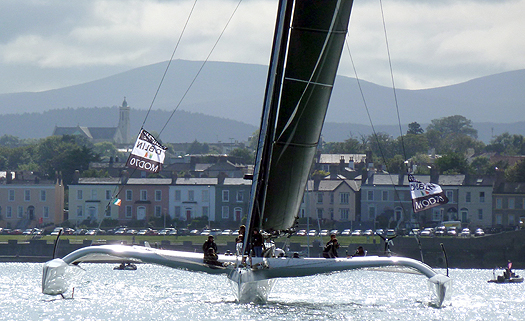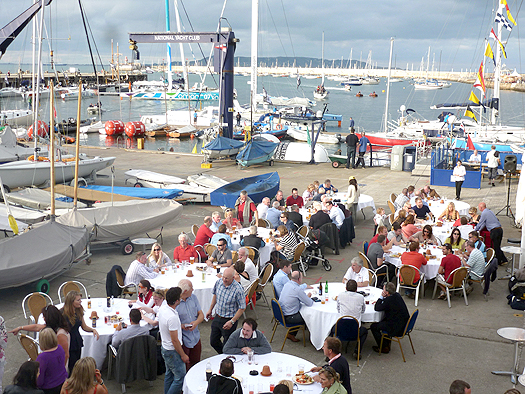#mod70–When Steve Fossett's 60ft trimaran Lakota came into Dun Laoghaire Harbour after setting a well nigh unbeatable Round Ireland record in September 1993, it was Dublin Bay's first introduction to the new generation of ultra-light speed machines, which were sweeping away long-standing time achievements by the fastest mono-hulls and the earlier waves of offshore multihulls.
Until this week, Lakota was our benchmark for the sharp end of multi-hull development. And she was a very good boat in her day. But as of midnight Wednesday, we're up to speed with the very latest thinking. The arrival of the five boats of the MOD 70 class at the end of Leg One of their European Tour has brought the awe-inspiring presence of machines which are 15 per cent bigger than Lakota, yet considerably lighter, and much faster.
That is, if they get the wind. Originally, the plan had been to race from Kiel out of the Baltic north of Scotland, then south to Dun Laoghaire. But the forecast – subsequently fulfilled – of gales in the high latitudes led to a re-routing through the English Channel. In this upside-down summer, they found precious little wind down south.

Manoeuvring for the start with a boat that seems as wide as it's requires special skills. Photo: WM Nixon
But as they're one designs, they'd brilliantly close racing. The lead changed several times, and the finish in the faintest zephyrs on Wednesday night just minutes before midnight saw the three front runners crawl across the line in just 77 seconds. That would be impressive in club racing. But in a 1300 mile offshore race, it's sensational.
Michel Desjoyeaux and his crew racing Foncia snatched it from Yann Guichard on Spindrift by 32 seconds, with Sebastian Josse and the Groupe Edmond de Rothschild team 45 seconds further back. Another 35 minutes elapsed before Steve Ravusin brought Race for Water to the finish. And then 1 hour and 34 minutes behind the leader, the fifth-placed Oman glided across in virtual calm, the crew including international multihull legend Brian Thompson who was with the late Steve Fossett – as were the National YC's Con Murphy and Cathy MacAleavey – when Lakota did the business 19 years ago.
When they went out for the first three City Races yesterday, hopes were high that the MOD 70s would get the kind of breezes in which they become truly spectacular, as the early afternoon gave a hint of a decent sea breeze filling from the southeast. But in early September, even when summer is doggedly clinging on, there just isn't the dynamic to create a fresh onshore wind, and though boats speeds of up to 14 knots were recorded in mid-afternoon, the winds were mostly light.
But it provided an ideal setup to observe these extraordinary machines in close-up, and for this reporter it was an excellent opportunity to tick several boxes at once, as we went to sea aboard Hal Sisk's remarkable 63ft "motor launch" Molly Bawn, an exquisite Nigel Irens design, built in Denmark, which is so easily driven in her elegant hull that they're able to measure fuel consumption by the litre.
So it was a dizzy combination, the sheer style of Molly Bawn, and the five MOD 50s zooming about with a deceptively relaxed air. A bit too relaxed in the case of Oman – they missed the first race through clobbering a rock with a daggerboard in Scotsman's Bay while being too enthusiastic about getting near the spectators on shore, though I think it was a little unkind of one non-sailor to comment that this was the most exciting thing that happened all afternoon.
By the time Oman re-joined for Race 2, Michael Desjoyeaux with Foncia was showing the sort of consistency which wins any boat racing series. These freakish machines, with hulls so narrow that the main crossbeam is actually thicker, really do race more or less like normal boats, which takes some skill in pre-start manoeuvres. But then, the sudden acceleration which results from getting the trim just right, means that massive gaps open out in seconds.

Weird and wonderful – a Mod 70's very slim main hull is narrower than the depth of the crossbeam. Photo: WM Nixon
Equally, of course, huge leads can disappear in a waft of wind. By the third race, Foncia was firmly in the points lead, and a new westerly drifting down the bay was indicated by the aroma of several happy barbecues ashore, not least at the National YC where hundred of happy punters were finding that this business of racing state of the art multihulls can be a notably thirst and hunger inducing affair.

Apres sailing at the National YC – quite something for a September evening after the worst summer on record. Photo: WM Nixon
For a September evening after the worst summer on record, it was wuite something. Today, with Dun Laoghaire en fete, the five boats will be showing their exceptional speed potential with an afternoon of racing and speed trials from 2.0pm to 5.0 pm off Dun Laoghaire harbour and along the coast to Sandycove point. Then tomorrow afternoon it's back to serious work – Leg 2 of 1215 miles from Dun Laoghaire to Cascais in Portugal, with a good sou'wester in prospect.
While the MOD 70 circuit is the new sailing going very public indeed, down in Kinsale they're geared up for one of the classics of international sport, a week of racing for the Dragon Gold Cup which dates back to 1937. A remarkable fleet of 60 boats has converged on the south coast port, and with Simon Brien from Belfast Lough already putting down a marker by winning the class's historic Edinburgh Cup back in July, the thriving Irish fleet includes several favourites for the Gold.
Meanwhile both the 1720s and the Laser SB20 (formerly the Laser SB3) were showing they're in good heart with major championships last weekend, Mark Mansfield and Terry English of Crosshaven taking the 1720 Euros at Baltimore in the last race, while Ben Duncan of Howth emerged from the pack to win the SB20 Nationals.
This weekend at Malahide, we've a geographical conundrum. At its newly refurbished dinghy headquarters on the Broadmeadow, Malahide YC is hosting more than a hundred very junior helms in the International Optimist Connacht Championship. Is this inter-provincial confusion, or what? We're assured that Malahide is the Connacht of Howth, and geography can be stretched from there.































































